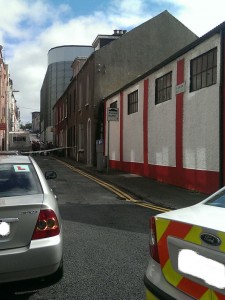Hatchets lay strewn on the Anne Street tarmac on Wednesday afternoon last. The front door of one house had been badly damaged, while windows on the property, along with those of a camper van and people carrier parked nearby, had been smashed in.
At either end of Anne Street, between Penrose Lane and Bridge Street, the cordon tape deployed by Gardaí at the scene was billowing strongly in the lunchtime breeze.
There was an unmarked car on the Penrose Lane side and a squad car positioned just off Bridge Street with officers in stab vests also on the scene.
For the first time in my life, I saw a technical examination taking place right in front of me, as one Garda meticulously examined the smashed windscreen of the people carrier.
One lady I spoke to who lives nearby looked bewildered, if not entirely surprised by what had gone on.
She told me about another fight in the locality that had happened a few weeks previously, involving, so she told me, two groups entirely separate to those responsible for last week’s madness in broad daylight.
“Iron bars and hatchets – weapons of choice for a lot of them,” said a City & County Council worker, who was in a truck which paused briefly on Penrose Lane briefly as I filled him in, as best I could, on the incident.
“How someone wasn’t seriously hurt is unbelievable,” I replied, as the lads moved on and went about their business.
Someone else I spoke to over the phone just minutes later told me about an alleged domestic violence incident he’d been made aware of in the Hennessy’s Road area the previous night.
Added to that, a figure well-known to Gardaí (we all know what that means) had, a few weeks back, been reportedly on the end of a bad beating which involved hammers.
Hammers. Iron bars. Hatchets. This isn’t the Middle Ages we’re talking about here. This is Waterford in 2015.
Digesting all of this information, trying to make sense of what I’d been told over the phone, the scene on Anne Street last Wednesday, and with the Ballybeg arson attacks hardly a fading memory, it would be easy to fear the worst for Waterford.
But it would be just as easy and grossly irresponsible to suggest that Ireland’s oldest city has turned into some criminal hotbed and that the Gardaí are fighting a losing battle.
However, to suggest that the force’s efforts to repel the more sinister criminal elements operating across Waterford are being stymied by resource issues is, in my view, undeniable.
The grim reality facing officers in Waterford whose work load includes tackling ‘high end’ organised crime is not dissimilar from the scenario facing their colleagues in other divisions. So it would be wrong and unfair to suggest that Waterford is being over-run by trouble makers.
Most of us with half an ear directed towards terra firma know who the vast majority of those trouble makers are. These people are widely known. The Guards are on first name terms with most of them. Judges must be sick of the sight of them.
But these people don’t represent the 90-plus per cent of us who go about our business peacefully, lawfully and with some civic sense about the place we were born in, live in and work in. They don’t represent Waterford. They don’t represent Ireland.
Human life is our most precious commodity. Safeguarding life and protecting our law-abiding citizens ought to be aggressively discussed during the forthcoming general election campaign. But punishing those who consistently flout the law and endanger others through their illegal activities should be debated in equal measure and with equal passion.
For me, they represent a far greater civic and social threat to society than any water meter installer, yet where is the widespread public and indeed political outrage when it comes to repeat criminals?
Consider the words of retiring Limerick-based Garda Superintendent Frank O’Brien back in September 2013.
“We are going through a period where there has been no recruitment to An Garda Siochána for a number of years, and fast approaching one of the longest periods ever where there has been no recruitment,” he told The Limerick Leader. “The impact of that will not be felt today or tomorrow but in a number of years’ time.”
While recruitment has reconvened, the strength of the force remains lower than it ought to be, and when one considers the know-how and savvy lost when officers and detectives reach retirement age, the need for more men and women in blue becomes ever more critical.
Yet that staffing boost cannot be achieved hastily – nor can local intelligence gathering for that matter.
Frank O’Brien added: “Where you have a situation where people have to move out of their homes because of criminality, that’s very sad for society, and very sad for policing, because it shows there’s a failure somewhere – and that’s what was happening. People were pulling out and leaving behind the homes they had invested in. That’s very sad and frustrating when you see that happening and know your power to respond is limited.”
Parts of O’Connell Street and several adjoining streets/lanes between there and The Glen are not as hospitable as we’d wish them to be. I walk through this area five times a week. I see it. I’m in a good place to judge.
And while the Anne Street incident represents an extreme ill on that front, it would be naive to suggest that policing alone can address the ills party catalysed by poor planning when apartment block building was all the rage in the inner city


